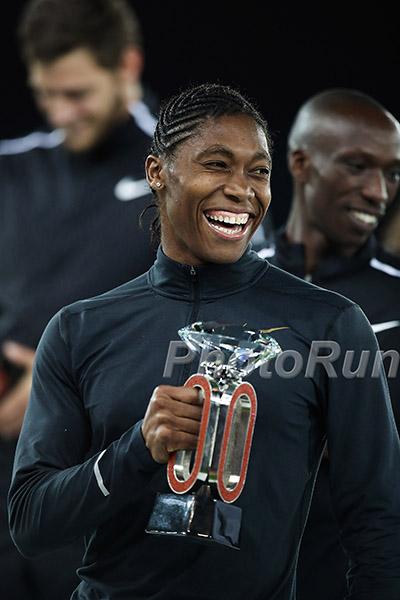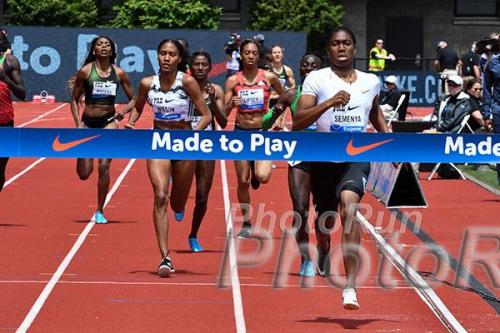I recall the win by Caster Semenya in Berlin in 2009. I also recall hearing the horrible booing of Ms. Semenya when she recieved her medal in 2009. Subsequent forensric research suggest the following: 1) Caster herself did not know why she was booed, and her staff, knowing of her issues, did not tell her, b) the IAAF could have dealt with the situation more humanely in 2008 and 2009, c) the situation is now a cause celebre, and has put the IAAF in a position, due only to themselves, as the sexual Grand Inquisitor.
 Caster Semenya, photo by PhotoRun.net
Caster Semenya, photo by PhotoRun.net
RelatedPosts
The following piece by Stuart Weir, on Caster Semenya, is a departure for Stuart. Both Stuart and I are troubled by this case. The truth is, it should have been managed by the IAAF much better in 2009. At this time, Caster Semenya has become the poster child for the categorization of female athletes. In a time when gender issues are at the forefront, Caster Semenya is a popular concern. (You also might enjoy Stuart’s Ten Questions with Caster Semenya: https://www.runblogrun.com/2018/11/ten-questions-to-caster-semenya-by-stuart-weir.html). Stuart Weir sees all the athletes he interviews a people with human frailties, imperfect souls, who are challenging their limits. Caster Semenya has had many challenges to meet. Consider how you would be with thousands booing you as you get a medal?
I admirer Caster Semenya, she has shown grace and style during this decade long debacle. I have watched her reach out to athletes she has defeated, and her presser with us in London 2017 is a prime example. The situation is of some complication. Rules do need to be made to protect the integrity of women’s athletics, and it has to be managed much better and with more consciousness than the global federation has used in prior efforts. At the end of the day, Caster Semenya has opened the sport to women from South Africa. Also at the end of the day, someone will be hurt by the decision.
Disturbing aspects of the IAAF Lausanne case.
There are a number of things which disturb me deeply about the current Caster Semenya case in Lausanne – and yes, I do think, of despite the IAAF’s protestations about categories of athletes, it is hard not to see the new rules as designed to stop Caster Semenya dominating the middle-distance races.
What I want to say has already been eloquently expressed by Billie Jean King on Twitter: “Forcing women w/naturally high testosterone to give up ownership of their bodies & take drugs to compete in sport is barbaric, dangerous, and discriminatory”. “Barbaric, dangerous, and discriminatory” are strong words but I think they are justified.
 Caster Semenya, photo by PhotoRun.net
Caster Semenya, photo by PhotoRun.net
The IAAF statement declares that their purpose is to “to ensure fair competition for all women”. In an excellent article in the London Times (20 February) Matthew Syed demonstrates that the concept of “fairness” in sport is misplaced. Syed’s argument includes a reference to Supreme Court Justice Antonin Scalia’s point that basketball discriminates against short people. In our own sport, a 6 foot 3 woman has a massive advantage over a 5 foot 6 women in the high jump.
To tell someone that they have to change the body they were born with before they can compete is a disturbing situation. The requirement for someone to take medication which is medically unnecessary for their health – and may well be shown in years to come to have side effects is unethical. A practicing doctor in the UK, to whom I spoke, told me she would be professionally unwilling to prescribe such drugs to a patient when there was no medical justification and when there could be damaging side-effects.
I read a quote from Jonathan Taylor, the IAAF’s lawyer, that if the IAAF did not win the case: “DSD and transgender athletes will dominate the podiums and prize money in sport, and women with normal female testosterone levels will not have any chance to win”. Really, then why is there pretty limited evidence of that at the moment? I have watched some magnificently competitive women’s 800 meters races such as Monaco 2017.
I am also reminded of the argument that was used against allowing Markus Rehm, the German amputee long jumper, to compete in IAAF events as opposed to IPC events, that people jumping with blades had an advantage. Rehm reasonably asked, if that were so, why was he the only para-athlete jumping eight meters.
While I’m sure the IAAF, is not racially motivated, it is, as the South African sports minister, Tokozile Xasa has pointed out interesting that the athletes who would be most affected all seem to be black. He said: “These regulations appear to be specifically targeting Caster Semenya. It’s a subtle racial incident we are observing”.
It is a fact of human life that people come in different shapes and sizes and inevitably in some sports some body types will have an advantage. Should we ban female high jumpers who are over 6 foot? After all, it is not “normal” for women to be more than 6 foot. It is extremely rare in Asia. So a logical conclusion, to protect the integrity of the sport, would be to ban these are abnormal woman for being too tall. Long distance races have tended to be dominated by east Africans. Do they have a genetic or other advantage which needs to be investigated? Or should we just ban them for being too fast?
Size and weight are significant contributing factors to the distance athletes can throw a discus or a javelin etc. To protect the fairness of the sport should we not have lightweight, middleweight, welterweight, heavyweight etc categories for throwing events like they do in boxing and wrestling? Or should the distance thrown be related to body weight? This would all be the slippery slope towards an IPC classification system with its 16 different categories of men’s 100 meter races?
The IAAF has set an arbitrary acceptance level of testosterone at five nanomoles per liter on the grounds that levels of testosterone give athletes an advantage. Is the IAAF going to set an acceptable level of testosterone for men too or is the advantage a male with higher levels of testosterone has over a male with lower levels, an acceptable unfairness?
It is an interesting question which unfairnesses the IAAF is happy to accept, and which it is no. But as readers of George Orwell’s Animal Farm know: “All animals are equal, but some animals are more equal than others“.
Caster Semenya is an amazing athlete – I speak as one who has seen all her major races since 2009 – who “has been turned into the freak act at a circus” (Syed). And those of us who have been around for a few years will remember the embarrassingly inept handling of her case by the IAAF in 2009.
I seem myself as loyal to the powers that be in our sport, but, and I am sad to say it. This time I hope the IAAF lose their case.
Author

Since 2015, Stuart Weir has written for RunBlogRun. He attends about 20 events a year including all most global championships and Diamond Leagues. He enjoys finding the quirky and obscure story.
View all posts




















